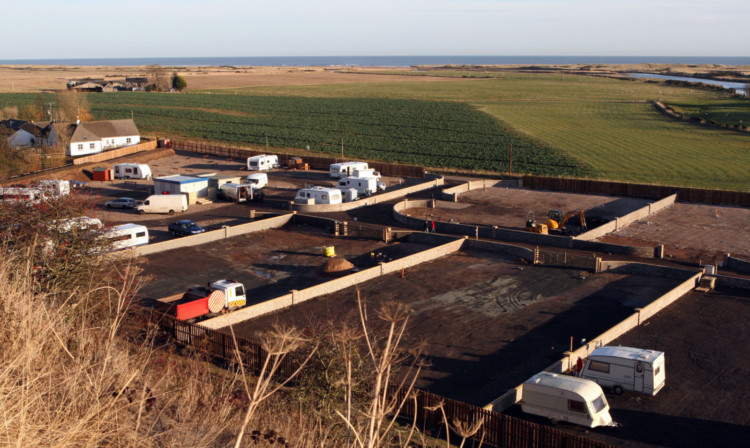Concerns from Mearns residents over a developing Travellers’ site near St Cyrus have been backed by a damning council report.
Aberdeenshire Council’s policy observations department has stated the site, which has been gradually developing since late September, fails to comply with five key planning policies, including rules on development in the countryside and safeguarding of resources and areas of conservation and agricultural land.
However, leading Angus organisation Article 12, which represents Travellers’ interests in Scotland, said the report does not take the human aspect of the application into account.
A two-month-long dispute has rumbled on in St Cyrus after a group of Travellers moved on to the land near Nether Warburton and began to dig it up to build a permanent caravan site in late September.
Work was started without planning permission and the land has been transformed into a functioning destination for the Travelling community, blocked off to the outside world by a large wooden perimeter fence.
A retrospective planning application was submitted by Traveller James McCallum to Aberdeenshire Council, seeking permission to build a 10 stance permanent holding for Gypsy caravans, the day after the group arrived on site.
A number of mixed representations have been received in response to the plans but the authority’s policy observations department has conclusively stated that the site breaks council planning policy on five counts.
The report, compiled by policy observations officer David Dunne, has been welcomed by those objecting to the site, as it reflects many of the previously aired public concerns for the environment and future of the site.
Mr Dunne said: “The development in question does not satisfy the criteria set out in SG RD1 (housing and business development in the countryside), as the development is not for the refurbishment or replacement of an existing or disused building; a suitable addition to the organic growth of a settlement or for the provision of a single dwelling associated with the succession of a viable farm.
“Additionally as the site is within the rural housing market area the following also apply the site is not an employment proposal; it is not an addition to an existing cohesive group.
“It is also not clear that any specific social or economic need for development in this rural location, remote from services, has been identified.”
Mr Dunne’s report also outlines the application and site’s lack of compliance with planning policy for special housing needs and Aberdeenshire Council’s guidance for Traveller site development.
He added: “On sites which have not been allocated, such as this site, it is necessary that the application show ‘a newly arising need can be proven’.
In this case the application has not shown why it is necessary to provide a permanent or temporary halting site in this remote location. As such they have not shown compliance with this policy.
“Leaving the ‘proven need’ aside, it would still be necessary to show compliance with a series of criteria in relation to any particular site.
“Assessing the proposed site against these criteria again shows that the site fails to comply with the policy.”
A St Cyrus resident, who declined to be named because of what he sees as the potential for “serious conflict” that could arise from the situation, said that the report seems to “back up” many of the opposition comments to the development.
He added: “It is shocking that they have a need to, and have taken such a long time to, have someone let them know what their own policy is. Hopefully the council will follow policy, treat this as any other development would be and reject it outright.”
Despite the department’s firm stance on the site’s lack of compliance, other statutory consultees have shown no objection, including Sepa and Scottish Natural Heritage.
Lynne Tammini, spokesperson for Article 12, said that while the report from Mr Dunne completes its own objectives, it does not take the over-arching social aspects of the application in to account.
She said: “Mr Dunne has done his job and it has been done well. It’s an objective assessment of the planning policy but what the committee and planning officers need to do is make sure that the planning and policy is viewed with equal weight to the social benefits of the site being there.
“This situation has the potential to begin to address the tensions which we all know about between the two communities. It is well documented.
“The Scottish Government set up a working group a couple of years ago to look at ways of building bridges between them. If you never meet someone from the other side then that just increases the fear and lack of understanding.
“If the local authority really is committed to helping build bridges between the two communities then this is, in my opinion, a great starting point.”
